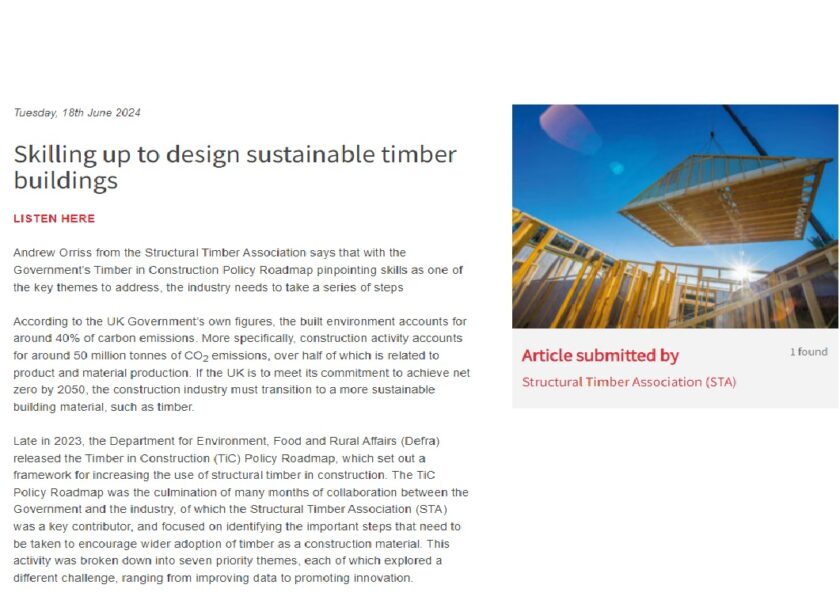Skills and training for designing more sustainable buildings
20/06/2024

The Government’s recent Timber in Construction Policy Roadmap has identified skills as one of the key themes that must be addressed to increase the use of timber in construction. But what does increasing skills, capacity and competency across the supply chain look like practically for the timber industry? Here, Andrew Orriss from the Structural Timber Association, delves deeper and outlines the next steps for the industry.
According to the UK Government, the built environment accounts for around 40% of carbon emissions, and more specifically, construction activity accounts for around 50m tonnes of CO2 emissions, over half of which is related to product and material production. If the UK is to meet its commitment to achieve Net Zero by 2050, the construction industry must transition to a more sustainable building material, such as timber.
Late in 2023, the Department for Environment, Food and Rural Affairs (DEFRA) released the Timber in Construction (TiC) Policy Roadmap, which set out a framework for increasing the use of structural timber in construction. The TiC Policy Roadmap was the culmination of many months of collaboration between the Government and the industry, of which the STA was a key contributor, and focused on identifying the important steps that need to be taken to encourage wider adoption of timber as a construction material. This activity was broken down into seven priority themes, each of which explored a different challenge ranging from improving data to promoting innovation.
One of the priority themes focuses on increasing skills, capacity and competency across the supply chain, explaining that increasing the use of timber in construction requires an appropriately skilled and competent workforce which is confident in the use and application of a range of timber systems. Additionally, attracting new entrants, along with up-skilling and re-skilling existing workforce practitioners is essential in achieving this.
So, how does this relate to the design and architecture in the build process? In order to successfully transition to timber as a construction material, we cannot simply replace other materials in a like-for-like fashion. Instead, we must design with timber in mind – not only to make the best use of the material, but to ensure that it is used in the most efficient way. As such, early collaboration at the design stage between the client and architects, along with any other key stakeholders is crucial in order to achieve sustainable buildings with high performance and energy efficiency. There is more to be done, however in engineering, architecture and design, education and training institutions have begun to rise to the challenge through a number of programme and schemes.
Additionally, the STA have launched a new skills hub to provide STA members and the structural timber community and the wider construction industry with the latest information and guidance on sector specific skills, training, and education. This Skills Hub also includes the STA’s Installer Training Scheme which gives assurance to designers that timber systems can be correctly installed.
This can be viewed as a very positive start for increasing skills and competency within the architectural and design sectors, but there are still some key opportunities for further progress.
Firstly, more promotion of Design and Technology qualifications in schools and colleges and developing clear construction career pathways to entice those with an interest in building more sustainably will propel the younger generation of professionals toward building with timber. Next, broadening the availability for short course modular training provisions will provide much more scope and opportunity for up-skilling or re-skilling the workforce. Another key opportunity could lie with new and emerging Continued Professional Development (CPD) requirements which would allow industry to keep pace with topics such as timber engineering and whole life carbon.
Ultimately, a lot of great progress has been made, but this year and the next few years present the greatest opportunity the industry has had in addressing Net Zero and truly adopting more sustainable building materials. The TiC Policy Roadmap has outlined many of these opportunities, and now all we need is the buy-in from architects and designers that are motivated to build more sustainable buildings.
As such, the STA has announced a new, free event ‘Navigating Structural Timber Construction to Address Net Zero’, taking place on the 2nd of July 2024 at RIBA’s London headquarters.
Aimed at architects and structural engineers, the event features high-profile speakers from organisations such as RIBA, Waugh Thistleton, Tate + Co and dRMM Studio. The event will give delegates the chance to discover how their industry peers have transitioned to using more timber, with a focus on sharing best practice advice.
To find out more, click here.